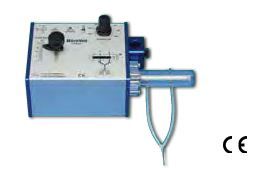MicroVent Ventilator for Prenatal Mice (Model 848), Single Animal Volume Controlled
The MicroVent Ventilator is a constant-volume respiration pump operating on the Starling principle. Unlike conventional units for larger animals, this ventilator employs a rotary plunger and has no valves. During each ventilation cycle, the plunger performs a synchronized forward and rotating movement. Cleverly arranged bores and channels in the cylinder and plunger control inspiration and expiration during each stroke of the plunger.
- Ideal for very small animals, perinatal mice, birds
- Stroke volume range from 0 to 130 µl
- Ventilation rate from 60 to 400 breaths/minute
- Simple adjustment of stroke volume while running
- Valveless piston pump, no valves to clog
- Very small instrument/circuit dead space volume
- Compact construction, place close to animal
- No vibrations, very low noise .
The extremely light weight and compact construction, in addition to the convenient rod clamp, allow the MicroVent Ventilator to be positioned directly next to the animal.
The MicroVent Ventilator is a constant-volume respiration pump operating on the Starling principle. Unlike conventional units for larger animals, this ventilator employs a rotary plunger and has no valves. During each ventilation cycle, the plunger performs a synchronized forward and rotating movement. Cleverly arranged bores and channels in the cylinder and plunger control inspiration and expiration during each stroke of the plunger.
Key Features
- Ideal for very small animals, perinatal mice, birds
- Stroke volume range from 0 to 130 µl
- Ventilation rate from 60 to 400 breaths/minute
- Simple adjustment of stroke volume while running
- Valveless piston pump, no valves to clog
- Very small instrument/circuit dead space volume
- Compact construction, place close to animal
- No vibrations, very low noise
How It Works
The extremely light weight and compact construction, in addition to the convenient rod clamp, allow the MicroVent Ventilator to be positioned directly next to the animal. Typical setups with larger ventilators produce large tubing and instrument dead space volumes. These larger volumes introduce greater system compliance which can affect the accuracy with which the full tidal volume is introduced into the animal's lungs. With the MicroVent, the tidal volume error due to system compliance is reduced to less than 3 µl. Tidal volume and respiration rate can be set exactly to the values required for animal ventilation. The level of precision and control available to the investigator minimizes the danger of hyperventilation or hypoventilation. The tidal volume can be varied continuously from 0 to 130 µl during operation without having to interrupt ventilation. The respiration rate is also continuously adjustable from 60 to 400 strokes/min. The expired air can be recovered at the collection port for sampling, recycling or for the generation of a positive end-expiratory pressure (PEEP). Room air or any non-explosive gas mixture can be used to feed the pump intake.
Components
A multi-gas inlet adapter is available for the MicroVent so that alternate gas mixtures and nebulized substances are delivered to the MicroVent inlet port at atmospheric pressure. The adapter provides ports for multiple selectable gas mixtures (hypoxic, anesthetic...) and a port for the Aerosol Nebulizer.
| Voltage Range 73-3591 73-3590 |
115 VAC 230 VAC |
| Number of Animals | 1 |
| Species | Perinatal mouse, small bird |
| Control Modes | Volume |
| Gas Supply | Room air or non-flammable mixed gas |
| Display | None |
| IE Ratio,% | 1:1 |
| PEEP | Provided via attachment of water column |
| Respiration Rate | 60 (min) to 400 (max) breaths/min |
| Repiration Rate Note | Continuously adjustable from 60 to 400 breaths/min |
| Sigh Frequency | None |
| Sigh Pressure | Not available |
| Tidal Volume | 0,03 (min) to 0.13 (max) ml/stroke |
| Stroke Volume | Continuously adjustable from 0 to 130 µl |
| Weight Range | 1 (min) to 50 (max) g |
| Dimensions, W x H x D | 3.9 x 3.1 x 7.9 in (10 x 8 x 20 cm) |
| Net Weight | 2.2 lb (1 kg) |
| AC Adapter Weight | 0.7 lb (0.3 kg) |
| Certifications | CE |
Cannula
| 73-2737 | |
| Animal Species | Mouse |
| Length, mm | 28 |
| Note | Length listed is total cannula length |
| OD, mm | 1.0 |
| Y-Adapter, mm | 3.0 |
Anne Hilgendorff , Kakoli Parai , Robert Ertsey , Edwin Navarro , Noopur Jain , Francis Carandang , Joanna Peterson , Lucia Mokres , Carlos Milla , Stefanie Preuss , Miguel Alejandre Alcazar , Suleman Khan , Juliet Masumi , Nancy Ferreira-Tojais , Sana Mujahid , Barry Starcher , Marlene Rabinovitch , Richard Bland (2015 ) Lung matrix and vascular remodeling in mechanically ventilated elastin haploinsufficient newborn mice Am J Physiol Lung Cell Mol Physiol
Sergey A. Sosunov, Xavier Ameer, Zoya V. Niatsetskaya, Irina Utkina-Sosunova, Veniamin I. Ratner, Vadim S. Ten (2015 ) Isoflurane Anesthesia Initiated at the Onset of Reperfusion Attenuates Oxidative and Hypoxic-Ischemic Brain Injury PLoS One
Anne Hilgendorff , Kakoli Parai , Robert Ertsey , G. Juliana Rey-Parra , Bernard Thébaud , Rasa Tamosiuniene , Noopur Jain , Edwin F. Navarro , Barry C. Starcher , Mark R. Nicolls , Marlene Rabinovitch , Richard D. Bland (2012 ) Neonatal mice genetically modified to express the elastase inhibitor elafin are protected against the adverse effects of mechanical ventilation on lung growth Am J Physiol Lung Cell Mol Physiol
Veniamin Ratner1, Sergey A. Sosunov1, Zoya V. Niatsetskaya1, Irina V. Utkina-Sosunova1, and Vadim S. Ten1 (2013 ) Mechanical Ventilation Causes Pulmonary Mitochondrial Dysfunction and Delayed Alveolarization in Neonatal Mice Am J Respir Cell Mol Biol

